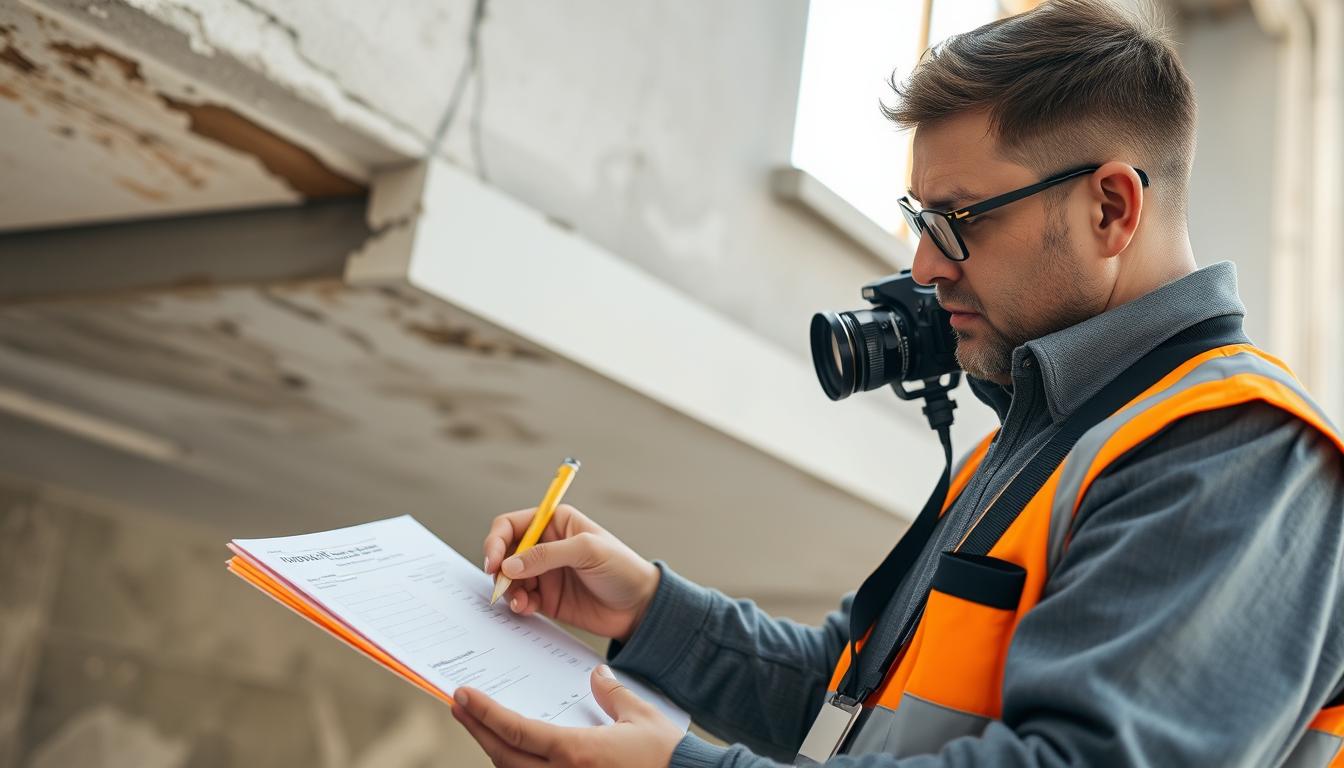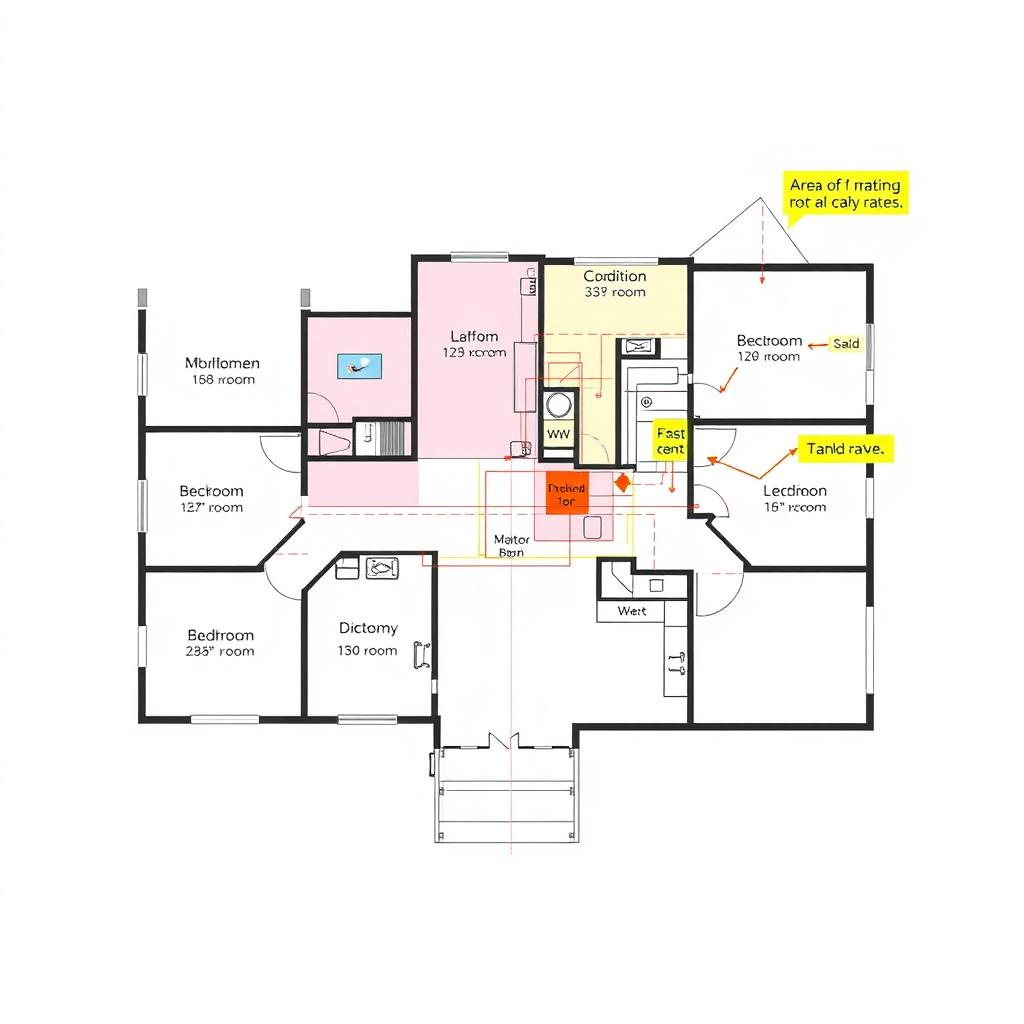A Level 3 Building Survey represents the most thorough property assessment available for homebuyers and property professionals. This comprehensive guide provides real examples, report structures, and practical insights to help you understand what a professional Level 3 survey entails and how it can protect your property investment.

Need a Professional Building Survey?
Get instant quotes from RICS Chartered Surveyors in your area.
Purpose and Importance of Level 3 Building Surveys
A Level 3 Building Survey, formerly known as a Structural Survey, provides the most detailed assessment of a property’s condition. It’s designed to give you comprehensive information about the construction, condition, and defects of a building, helping you make informed decisions about your property purchase or renovation plans.
When You Need a Level 3 Survey
- For older properties (typically over 50 years old)
- Listed or heritage buildings with historical significance
- Properties with unusual construction methods or materials
- Buildings that have been extensively altered or renovated
- Properties showing visible signs of structural issues
- When planning significant renovations or alterations
Benefits of a Level 3 Survey
- Identifies hidden defects that could cost thousands to repair
- Provides detailed analysis of structural integrity
- Includes cost estimates for necessary repairs
- Offers expert advice on maintenance priorities
- Can be used as a negotiation tool for property price
- Gives peace of mind about your investment decision

Key Components of a Professional Level 3 Building Survey Report
A comprehensive Level 3 Building Survey report follows RICS (Royal Institution of Chartered Surveyors) guidelines and includes several essential components. Understanding these elements helps you interpret the findings and take appropriate action.
Property Information
- Detailed property description
- Construction type and materials
- Approximate age and history
- Location and environmental factors
- Services and utilities assessment
Structural Assessment
- Foundation and substructure analysis
- Wall construction and condition
- Roof structure and covering
- Floor construction and stability
- Timber and structural elements
Defect Analysis
- Detailed defect descriptions
- Condition ratings (1-3 scale)
- Cause of defects identification
- Repair recommendations
- Prioritized action plan

A professional Level 3 Building Survey report should be clear, detailed, and actionable. It should avoid technical jargon where possible and explain findings in terms that clients can understand. The report should also include photographs documenting key findings and areas of concern.
Want to See a Sample Report?
Download our comprehensive Level 3 Building Survey example report.
Detailed Example Survey Document
Below is a breakdown of what you can expect to find in a professional Level 3 Building Survey report. This example highlights the level of detail and structure that characterizes a comprehensive building assessment.
| Report Section | Contents | Purpose |
| Introduction | Property details, client information, survey date, weather conditions, limitations | Establishes scope and context of the survey |
| Property Description | Construction type, approximate age, size, layout, orientation, modifications | Provides baseline understanding of the property |
| External Condition | Roof, chimneys, gutters, walls, windows, doors, drainage | Assesses external envelope integrity |
| Internal Condition | Ceilings, walls, floors, staircases, fireplaces, kitchen, bathrooms | Evaluates internal elements and finishes |
| Services | Electrical, plumbing, heating, ventilation, drainage | Reviews essential building services |
| Structural Assessment | Foundations, load-bearing elements, structural movement | Analyzes structural integrity |
| Defects Analysis | Detailed description of defects, causes, implications | Identifies issues requiring attention |
| Recommendations | Repair advice, maintenance suggestions, further investigation needs | Provides actionable guidance |
Structural Assessment Example
The structural assessment section of a Level 3 Building Survey provides detailed analysis of the property’s structural elements. Here’s an example of what this might include:

“The property’s load-bearing walls show signs of historical movement, evidenced by stepped cracking to the southeast corner. Monitoring pins installed in 2018 indicate this movement has stabilized. The roof structure exhibits some deflection but remains structurally sound with no evidence of excessive loading. Floor joists in the kitchen extension require reinforcement where notched for service penetrations.”
– Extract from sample Level 3 Building Survey report
Sample Level 3 Report Structure
- Property overview table
- Condition ratings key
- Priority action flowchart
Material Analysis
A thorough Level 3 Building Survey includes detailed analysis of construction materials and their condition. This helps identify potential issues related to specific materials and construction methods.
| Building Element | Material | Condition Assessment | Recommendations |
| External Walls | Solid brick (215mm) | Generally sound with localized areas of spalling brickwork and deteriorated pointing | Repoint using lime mortar to affected areas; replace spalled bricks |
| Roof Structure | Traditional cut timber | Evidence of past woodworm activity; 2 rafters showing signs of water damage | Treat for woodworm; reinforce or replace damaged rafters |
| Roof Covering | Natural slate | Multiple slipped and cracked slates; nail fatigue evident | Comprehensive roof overhaul required within 2 years |
| Ground Floor | Suspended timber | Localized softening near bathroom; inadequate ventilation to subfloor | Improve subfloor ventilation; replace affected floorboards |
| Windows | Timber sash | Decayed sills and lower rails; several sashes painted shut | Overhaul windows; replace decayed timber elements |

Defect Classification System
Level 3 Building Surveys use a standardized condition rating system to classify defects according to their severity and urgency. This helps prioritize repairs and maintenance actions.
| Condition Rating | Description | Action Required |
| 3 | Defects that are serious and/or need urgent repair, replacement or investigation | Immediate action required; may affect purchase decision |
| 2 | Defects that need repairing or replacing but are not considered serious or urgent | Repairs needed but not immediately; budget for future work |
| 1 | No repair is currently needed; normal maintenance required | Monitor as part of regular maintenance |
| NI | Elements not inspected | Further investigation may be required |
Important: The condition rating system provides a standardized way to communicate the severity of defects. A single Condition Rating 3 defect could significantly impact your purchase decision or require substantial budget allocation for repairs.

Cost Estimation Tables
A comprehensive Level 3 Building Survey includes estimated costs for necessary repairs and maintenance. These estimates help buyers understand the financial implications of the survey findings.
| Defect | Condition Rating | Estimated Cost Range | Timeframe |
| Roof replacement (natural slate) | 3 | £8,000 – £12,000 | Within 12 months |
| Damp treatment to basement | 3 | £3,500 – £5,000 | Immediate |
| Timber window overhaul | 2 | £2,500 – £4,000 | Within 2 years |
| Repointing brickwork | 2 | £1,800 – £2,500 | Within 2 years |
| Electrical system upgrade | 2 | £2,000 – £3,500 | Within 12 months |
Note: Cost estimates are indicative only and based on average prices at the time of the survey. Actual costs may vary depending on the contractor, materials used, and the full extent of work required once repairs begin.
Need Accurate Repair Cost Estimates?
Get expert advice from RICS Chartered Surveyors who can provide detailed cost breakdowns.
Visual Elements in Level 3 Building Surveys
Professional Level 3 Building Survey reports include various visual elements to help clients understand the findings. These visual aids make complex information more accessible and highlight key areas of concern.
Photographs
Detailed images of defects, structural elements, and general property conditions provide visual evidence of findings.

Diagrams
Technical illustrations help explain structural issues, construction details, and proposed remedial works.

Floor Plans
Annotated layouts help locate defects and understand the spatial context of findings.

Risk Assessment Matrix Example
A risk assessment matrix helps quantify and visualize the severity and likelihood of identified issues, aiding in prioritization of remedial works.

| Risk Level | Description | Action Required |
| High | Serious defects with high likelihood of worsening | Immediate remedial action required |
| Medium | Significant defects or high likelihood of developing | Plan for repair within 6-12 months |
| Low | Minor defects with low likelihood of significant deterioration | Monitor and maintain as part of regular upkeep |
Real-World Scenario Examples
Understanding how Level 3 Building Surveys apply in different contexts helps illustrate their value and application. Below are three real-world scenarios demonstrating how these surveys address specific property challenges.

Heritage Property Survey Example
Property: Grade II listed Georgian townhouse, circa 1820
Key Findings:
- Original timber frame showing signs of beetle infestation requiring specialist treatment
- Lime plaster deterioration due to inappropriate modern cement repairs
- Roof structure compromised by previous amateur modifications
- Historic sash windows requiring specialist conservation rather than replacement
Outcome: Survey identified £42,000 of essential specialist repairs. Buyer negotiated £35,000 price reduction and proceeded with purchase with clear understanding of conservation requirements.

Commercial Building Defect Analysis
Property: 1970s office building with retail units at ground level
Key Findings:
- Extensive flat roof defects with water ingress affecting upper floor offices
- Reinforced concrete frame showing carbonation and spalling to exposed elements
- Non-compliant fire compartmentation between retail and office spaces
- HVAC system at end of serviceable life requiring complete replacement
Outcome: Survey revealed £180,000 of essential repairs and compliance issues. Buyer used report to negotiate staged repair program with vendor completing critical works prior to completion.

Residential Renovation Case Study
Property: 1930s semi-detached house requiring modernization
Key Findings:
- Structural movement to rear extension requiring underpinning
- Widespread damp issues due to failed cavity wall insulation
- Electrical system requiring complete rewire to meet current regulations
- Asbestos-containing materials identified in multiple locations
Outcome: Survey provided detailed renovation roadmap with prioritized works and budget estimates totaling £65,000. Buyer proceeded with purchase at reduced price with clear understanding of renovation requirements and sequence.
UK Building Regulations Compliance Checklist
A comprehensive Level 3 Building Survey should assess compliance with relevant building regulations. This checklist highlights key areas that should be evaluated during the survey process.
| Regulatory Area | Key Compliance Aspects | Common Issues |
| Structure (Part A) | Load-bearing capacity, structural stability, ground movement | Unauthorized removal of walls, inadequate lintels, foundation issues |
| Fire Safety (Part B) | Fire resistance, escape routes, compartmentation | Inadequate fire doors, compromised compartmentation, blocked escape routes |
| Ventilation (Part F) | Adequate air exchange, moisture control, extraction | Insufficient extraction in wet rooms, blocked vents, inadequate trickle ventilation |
| Energy Efficiency (Part L) | Insulation standards, thermal bridging, glazing performance | Inadequate insulation, non-compliant windows, thermal bridges |
| Electrical Safety (Part P) | Safe installation, appropriate certification, RCD protection | Uncertified work, outdated wiring, inadequate consumer units |
Important: Building regulation compliance issues can have significant implications for property owners, including enforcement action, insurance invalidation, and impact on future saleability. A Level 3 Building Survey should identify potential compliance issues and recommend appropriate remedial action.
Best Practices for Commissioning and Using a Level 3 Building Survey
To get the most value from your Level 3 Building Survey, follow these best practices throughout the process:
Before the Survey
- Choose a qualified RICS Chartered Surveyor with experience in similar properties
- Provide the surveyor with any available property information (previous surveys, planning permissions, building control approvals)
- Clarify any specific concerns you have about the property
- Ensure access arrangements are in place for all areas of the property
- Understand the limitations of the survey (e.g., inaccessible areas, specialist investigations required)
After Receiving the Report
- Read the entire report thoroughly, not just the executive summary
- Discuss any unclear findings with your surveyor
- Obtain specialist reports for any issues identified (e.g., electrical, structural engineer)
- Get quotes for necessary repair work to understand financial implications
- Use the findings to inform your purchase decision or negotiation strategy

Advantages of Level 3 Surveys
- Most comprehensive property assessment available
- Detailed analysis of all accessible parts of the property
- Identifies hidden defects that could be costly to repair
- Provides expert recommendations for remedial work
- Can be used as a negotiation tool for property price
- Offers peace of mind about your investment decision
Limitations to Consider
- More expensive than other survey types
- Cannot detect issues in inaccessible areas
- May recommend further specialist investigations
- Cost estimates are indicative only
- Findings represent a snapshot in time
- Cannot predict future issues that may develop
Ready to Commission Your Level 3 Building Survey?
Get quotes from RICS Chartered Surveyors specializing in comprehensive property assessments.
Frequently Asked Questions
How much does a Level 3 Building Survey cost?
Level 3 Building Survey costs typically range from £700 to £2,500+ depending on the property’s size, value, age, and complexity. Listed buildings, larger properties, and those with unusual features generally cost more to survey due to the additional time and expertise required.
How long does a Level 3 Building Survey take to complete?
The on-site inspection typically takes 4-8 hours depending on the property size and complexity. The surveyor will then need 3-5 working days to prepare the comprehensive report. In total, you should allow 1-2 weeks from commissioning the survey to receiving the final report.
What’s the difference between a Level 3 Building Survey and a Level 2 Homebuyer Survey?
A Level 3 Building Survey is more comprehensive than a Level 2 Homebuyer Survey. Level 3 surveys provide detailed analysis of the property’s construction, condition, and defects, including advice on repairs and maintenance. Level 2 surveys are less detailed, using a standardized format and condition rating system without the in-depth analysis and recommendations found in a Level 3 report.
Can I use a Level 3 Building Survey to negotiate the property price?
Yes, a Level 3 Building Survey is an excellent negotiation tool. If the survey identifies significant defects or necessary repairs, you can use this information to negotiate a price reduction or ask the seller to fix the issues before completion. The detailed cost estimates provided in the report give you concrete figures to support your negotiation.
Conclusion
A Level 3 Building Survey represents the gold standard in property assessment, providing comprehensive analysis of a building’s condition, construction, and defects. For older properties, listed buildings, unusual constructions, or properties requiring renovation, this detailed survey offers invaluable insights that can inform purchase decisions, renovation plans, and maintenance strategies.
By understanding the components of a professional Level 3 survey and following best practices for commissioning and using the report, you can maximize the value of this investment and protect yourself from unexpected property issues. Remember that while the cost of a Level 3 survey may seem significant, it represents a small fraction of the property’s value and can potentially save you thousands in unforeseen repair costs.
Protect Your Property Investment
Commission a comprehensive Level 3 Building Survey from RICS Chartered Surveyors.

